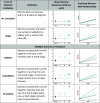Interactions among nutrients govern the global grassland biomass-precipitation relationship
- PMID: 40215280
- PMCID: PMC12012460
- DOI: 10.1073/pnas.2410748122
Interactions among nutrients govern the global grassland biomass-precipitation relationship
Abstract
Ecosystems are experiencing changing global patterns of mean annual precipitation (MAP) and enrichment with multiple nutrients that potentially colimit plant biomass production. In grasslands, mean aboveground plant biomass is closely related to MAP, but how this relationship changes after enrichment with multiple nutrients remains unclear. We hypothesized the global biomass-MAP relationship becomes steeper with an increasing number of added nutrients, with increases in steepness corresponding to the form of interaction among added nutrients and with increased mediation by changes in plant community diversity. We measured aboveground plant biomass production and species diversity in 71 grasslands on six continents representing the global span of grassland MAP, diversity, management, and soils. We fertilized all sites with nitrogen, phosphorus, and potassium with micronutrients in all combinations to identify which nutrients limited biomass at each site. As hypothesized, fertilizing with one, two, or three nutrients progressively steepened the global biomass-MAP relationship. The magnitude of the increase in steepness corresponded to whether sites were not limited by nitrogen or phosphorus, were limited by either one, or were colimited by both in additive, or synergistic forms. Unexpectedly, we found only weak evidence for mediation of biomass-MAP relationships by plant community diversity because relationships of species richness, evenness, and beta diversity to MAP and to biomass were weak or opposing. Site-level properties including baseline biomass production, soils, and management explained little variation in biomass-MAP relationships. These findings reveal multiple nutrient colimitation as a defining feature of the global grassland biomass-MAP relationship.
Keywords: diversity; grasslands; precipitation; primary productivity.
Conflict of interest statement
Competing interests statement:The authors declare no competing interest.
Figures





References
-
- Douville H., et al. , “Water cycle changes” in Climate Change 2021: The Physical Science Basis. Contribution of Working Group I to the Sixth Assessment Report of the Intergovernmental Panel on Climate Change, Masson-Delmotte V., et al., Eds. (Cambridge University Press, Cambridge, United Kingdom and New York, NY, 2021), pp. 1055–1210, 10.1017/9781009157896.010. - DOI
-
- Rockström J., et al. , A safe operating space for humanity. Nature 461, 472–475 (2009). - PubMed
-
- Bloom A. J., Chapin F. S. III, Mooney H. A., Resource limitation in plants-an economic analogy. Ann. Rev. Ecol. Sys. 16, 363–392 (1985).
-
- Chapin F. S., Bloom A. J., Field C. B., Waring R. H., Plant-responses to multiple environmental-factors. Bioscience 37, 49–57 (1987).
-
- Gleeson S. K., Tilman D., Plant allocation and the multiple limitation hypothesis. Am. Nat. 139, 1322–1343 (1992).
MeSH terms
Substances
LinkOut - more resources
Full Text Sources
Research Materials

